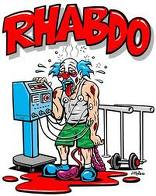ROD 062510
ROD
Friday, 25Jun10
Clean & Drive
10 rounds for time.
- 10 Hang cleans
- 8 Reclines
- 6 MB squat thrusts & jump
- 4 Knees to elbows
__________________________________________________________
“You can tell more about a person by what he says about others than
you can by what others say about him.” ~ Leo Aikman
___________________________________________________________
Exercise-Induced Rhabdomyolysis
Rhabdomyolysis is the name given to the breakdown of muscle fibers, which
results in the release of myoglobin into the bloodstream that can be harmful
to organ systems. Prolonged, strenuous exercise is a leading cause of rhabdomyolysis.
Significance
While rhabdomyolysis is not a normal risk associated with exercise, it can be brought on by severe exertion, such as marathon running or unusual amounts of high-impact calisthenics.
Explanation
When exercise continues long enough for the body to become depleted of oxygen and fat needed to continue producing energy, the body may begin to break down muscle fibers to use in place of fat. This causes the release of the protein myoglobin, which, when further broken down, contains compounds that can harm the body.
Symptoms
Early symptoms of rhabdomyolysis caused by exercise include red or brown urine, weakness and extreme muscle aches, tenderness and weakness. If the condition is allowed to continue, it can cause weight gain, fatigue, joint pain and seizures.
Complications
Possible complications of rhabdomyolysis include damage to the kidney tubules and acute kidney failure.
Treatment
Hydration through fluids and intravenous means are the primary means of treatment, and if caught early can usually prevent any permanent damage. Diuretics and bicarbonate may also be given to help flush the myoglobin compounds from the kidneys.

